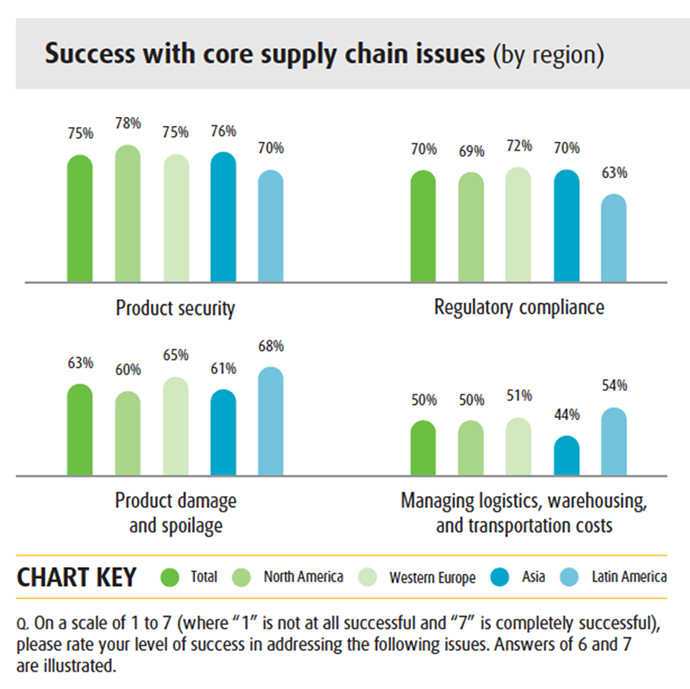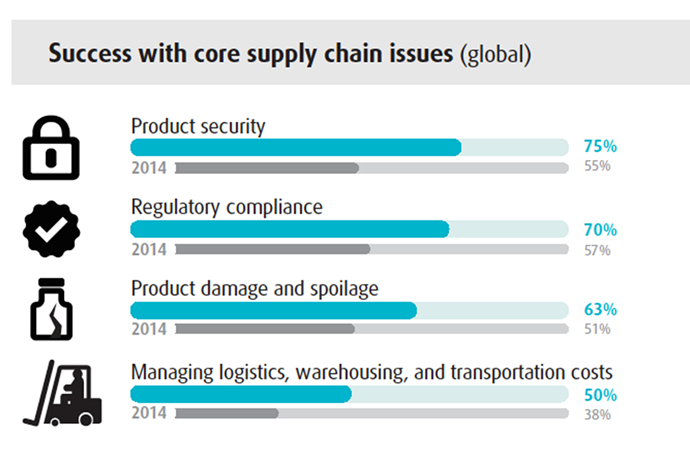The silver tsunami is not just a U.S.-centric, baby-boomer event — it’s one more ingredient in a recipe for a surge in global healthcare demand. Urbanization trends and a rising global middle class, factored with an aging world population will, on balance, increase chronic disease and healthcare demand as we age, become more affluent and urbanize.
The question is: Are supply chains ready to meet this demand under the framework of increasing regulatory oversight; cost pressures, high-value, temperature-sensitive healthcare products; and new degrees of supply chain interdependencies that are more vulnerable to disruption?

Each year, UPS takes the pulse of the industry with the UPS® Pain in the (Supply) Chain survey, conducted by TNS. The study targets logistics executives at pharmaceutical, medical device and biotech companies around the world and focuses on top supply chain concerns and successful strategies for managing them.
The 2015 survey underscores the need to remain vigilant in diagnosing pain points in healthcare logistics, and sharing strategies that firms leverage. Categories such as regulatory compliance and product security continue to pose challenges, while new and emerging areas prompt healthcare logisticians to think differently. UPS will continue to research and share insights on logistics challenges that keep healthcare executives up at night, while sharing best practices leveraged by the most successful supply chain decision-makers. Here are three main findings discussed in detail:
Product protection made moderate gains, but further improvements needed.
Healthcare companies in this year’s study reported success addressing product damage and spoilage issues. Year-over-year, product damage and spoilage success rates rose 12 percentage points from 51 percent to 63 percent. These are great results considering the growth in large molecule biologic therapies, which are vulnerable to temperature excursions that could render the therapy ineffective or even dangerous.

By 2018, seven of the top 10 drugs will be biologics requiring cold chain logistics. By comparison, an aspirin molecule contains about 25 atoms and is relatively stable, whereas a biologic monoclonal antibody molecule may contain 25,000 atoms or more and require stringent temperature-controlled logistics. More work is needed in time- and temperature-sensitive logistics from an end-to-end perspective to meet future needs.
Logistics and distribution partnerships were cited as the top successful strategy healthcare companies employed to address supply chain pain points, with 74 percent reporting success addressing product damage and spoilage by partnering with a higher-quality carrier. In the last few years, healthcare M&A has skyrocketed, and the idea of collaborative logistics models for the industry resonates as firms begin to realize the complexities of dovetailing healthcare distribution centers and maintaining regulatory licenses for existing and target markets. An asset-light global infrastructure model that allows logistics experts to contribute to corporate capital preservation initiatives means more dry powder for M&A and R&D, while allowing firms to plug into outsourced infrastructure in key markets as demand grows.
Consider that in 2011, healthcare spend in China was $357 billion. In 2020, it is expected to reach $1 trillion. That’s the kind of growth we’re looking at as middle class and aging populations expand throughout Asia, Latin America and Europe. As firms eye new markets, mitigating product damage and spoilage in a way that is cost-effective will become even more critical to meet demands. Successful decision-makers are mitigating risk of delay or temperature excursion by leveraging transportation network thermal profiling studies conducted by some integrators. They are also leveraging shipment monitoring devices and proactive tracking and over-watch bundles that allow the transportation provider to monitor, predict, intervene and even insure products.
Major inroads needed in contingency planning and cost management.
Supply chain networks are becoming more complex, and contingency planning has never been more important. Yet, in this year’s survey, a hefty 40 percent of healthcare logistics executives put contingency planning low on the priority list. This likely can be attributed to competing priorities such as compliance and product protection, coupled with the belief that disruptions, though high-impact, are a low probability. It is worth noting that more logistics executives are seeing value in contingency planning, but far too many still leave themselves vulnerable to disruptions in cases of unplanned events.
One only needs to recall the devastating effects of the Japanese earthquake and tsunami of 2011 or Superstorm Sandy in 2012. The importance of having alternate distribution networks and additional transportation capabilities has never been more vital when billions of dollars of inventory are at stake. The key is combining supply chain optimization analysis with resiliency work to develop newer, more efficient models that have shock absorbers — the mixture of optimization and risk mitigation will be more palatable to executives than pure redundancies and back-up plans alone. Outsourced distribution scenarios play a key role here.
Also in this year’s survey, only 50 percent of healthcare logistics executives succeeded at managing transportation, warehousing and distribution costs, which represents a 12-percent gain over last year but is still low. Healthcare executives report rapid business growth, fluctuations in fuel and raw materials costs, increasing regulations, and new market expansion as the biggest challenges to managing supply chain costs.
Product security, regulatory compliance have strong pulses.
What’s most interesting about this year’s survey is the optimism with product security —75 percent of healthcare and life sciences execs reporting success in this area. This represents a 20-percent increase over last year. Credited are investments such as bar-coding, serialization and better cooperation with law enforcement agencies, increasing sentiment that gains are being made.
With the U.S. Congress enacting the Drug Supply Chain Security Act in 2014, healthcare companies are getting in lockstep with establishing an interoperable track-and-trace system where manufacturers would serialize their product, i.e. a unique numerical identifier. The legislation allows the serialization process to develop within 10 years, and as serialization progresses, new advancements such as mobile technologies by consumers will likely continue to be game-changers. In years to come, it is expected that healthcare companies will make even bigger strides in product security.
Big gains are also being made by healthcare execs in regulatory compliance. Seventy percent (a 13-percent jump over last year) of this year’s respondents are more successful with navigating a complex regulatory environment. This is welcome news, since the industry can expect only more scrutiny, regulations and compliance mandates moving forward.

For example, the European Commission Guidelines of November 2013 on Good Distribution Practices of medicinal products are drastically changing cold chain standards and practices, with a more systematic use of quality agreements between shippers and their 3PLs, more frequent audit requirements, and a renewed focus on CRT shipments, whose quality standards are now closer to those of refrigerated shipments (2-8°C).
The healthcare industry is challenged to do more with less, and the question of where to invest and what to outsource is a lofty, necessary analysis for any effective business strategy. Firms that focus on core competencies and free up capex reserved for logistical assets have the opportunity to leverage collaborative solutions needed to face supply chain challenges such as cost management, regulatory compliance, product security, mitigating product damage and spoilage, and gaining better inventory visibility.
All of these issues will remain top supply chain priorities for healthcare companies even as marketplace trends shift toward higher levels of service, and more sensitive, high-value biologics and medical device products enter the market. Given the fluid landscape, how healthcare logistics decision-makers implement major shifts in their supply chain configurations will make all the difference in converting nagging “pains” into strategic “gains” in their supply chain.
Robin Hooker is director of healthcare marketing for UPS. To learn more about other top findings from this year’s UPS® Pain in the (Supply) Chain survey, click here.
